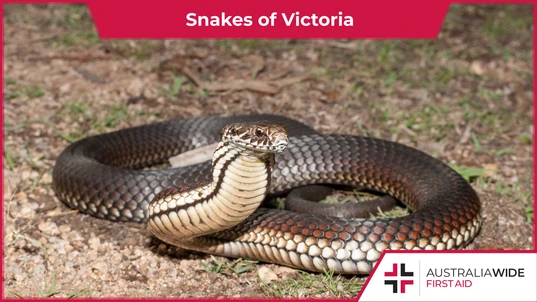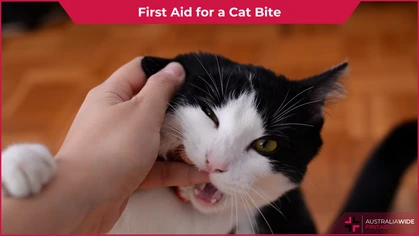First Aid for the Snakes of Victoria

Bites and Stings

Recent flooding in Victoria has displaced several venomous snake species and forced them into homes, playgrounds, and workplaces, including the Highland copperhead (pictured). It is important to be familiar with the characteristics and preferred habitats of these snakes, as their bites can cause a host of deadly symptoms.
Due to recent warm weather and flooding, Victoria is currently experiencing an influx of venomous snakes in homes, playgrounds, and workplaces. In this article, we will describe the characteristics and preferred habitats of five of the most dangerous snakes found in Victoria. While these snakes will never go out of their way to attack you, their venom is designed to stun, numb, or kill other animals and so can cause a host of deadly symptoms in humans. We also cover snake bites in our general and childcare first aid courses. We have training locations throughout Victoria and every other state in Australia - head to our Locations page to enrol in a course near you today.
Tiger snakes typically shelter in or under fallen timber, matted vegetation, and disused animal burrows close to watery environments or degraded areas, including creeks, swamps, and pastoral lands.
The Tiger snake
The Tiger snake (Notechis scutatus) is renowned for having yellow and black cross-bands along its back and sides. However, not all individuals have this pattern, and you should also look out for the following identifying characteristics:- A thick, muscular body that generally ranges from 1 to 1.5 m long
- A wide, deep head that is almost imperceptible from their body
- Body scales ranging from dark olive brown to black

Eastern brown snakes typically shelter in or under fallen logs, animal burrows, and man-made debris across a wide range of habitats, save for rainforest and alpine forests. They can even be found in suburbs and land modified for agriculture.
The Eastern brown snake
The Eastern brown snake (Pseudonaja textilis) has the following identifying characteristics:- A slender to moderately built body that is generally 1.5 m long but can grow up to 2 m
- Smooth, slightly glossy scales on their back and sides that can be almost any shade of brown, from near black to light tan
- Their underside is generally cream in colour with pinkish-orange blotches

Red bellied black snakes typically shelter in or under logs, mammal burrows, and thick grass clumps close to moisture in forests, heaths, and rural properties and other disturbed areas.
The Red bellied black snake
The Red bellied black snake (Pseudechis porphyriacus) has the following identifying characteristics:- A moderate to robustly built body that can range from 1.5 to 2 m long
- The scales on their back and sides are smooth, glossy, and uniformly black in colour
- The lowermost rows of scales on their sides are bright crimson and fade to orange or pink as they reach the middle of the belly

The Lowland copperhead snake (pictured) often takes shelter in or under boulders, man-made debris, and dense vegetation close to water in grassland, woodlands, and heavily disturbed areas.
Highland and Lowland copperhead snakes
Highland copperheads (Austrelaps ramsayi) and Lowland copperheads (Austrelaps superbus) share many identifying characteristics, including:- A muscular, moderately robust body - for Highland individuals this can reach a total length of 1.15 m, while Lowland individuals can grow to 1.45 m
- Semi-glossy scales on their back and sides that are uniformly grey brown to blackish in colour, sometimes with a brownish or orange flush. They also have a coppery-brown colouration on their head
- The lowermost rows of scales on their sides are enlarged and typically paler in colour, while their belly colour can range from cream to grey

The Eastern small eyed snake is known to shelter in or under stones, fallen timber, and rock crevices in habitats with a high moisture level, including rainforest, as well as woodlands and rock outcrops.
Eastern small eyed snake
The Eastern small eyed snake (Cryptophis Nigrescens) has the following identifying characteristics:- A small to moderately sized body that generally averages 0.5 m in length
- The scales on their head and body are smooth, glossy, and uniformly blue-black in colour
- The scales on their belly can range from cream to bright coral pink with dark blotches - however, unlike Red bellies, this colouration does not extend beyond their belly
Symptoms of a snake bite
It is important to note, it may take up to 2 hours for these symptoms to become apparent:- Bleeding
- Swelling and bruising
- Severe pain
- Bite marks present on the skin
- Anxiety
- Nausea and vomiting
- Irregular heartbeat and difficulty breathing
- Coma or death
First aid for a snake bite
It can be difficult to positively identify different types of snakes, as individuals of the same species can vary dramatically in colour, pattern, and size. As such, all snake bites should be treated as a medical emergency. If you or someone else is bitten by a snake, call Triple Zero (000) for emergency services and apply a pressure bandage as part of the Pressure Immobilisation Technique. It is important to remember that snake bites rarely cause fatalities, as modern anti venoms are typically effective at neutralising most snake bites. Likewise, snakes will never go out of their way to attack you - they will generally only bite people when threatened or provoked. As such, if you encounter a snake, do not attempt to approach, capture, or kill it. If you need a snake relocated from your home, contact a snake catcher instead.Final thoughts
Victoria is home to 5 venomous species of snake that can cause a host of deadly symptoms in humans, ranging from bleeding and swelling to irregular heartbeat and death. These deadly snakes will never go out of their way to attack you, and their bites will rarely cause death due to the effectiveness of modern anti venoms. If you do sustain a bite, follow the first aid procedure outlined in our Resource Library. We also cover snake bites in our general and childcare first aid courses. We have training locations throughout Victoria and every other state in Australia - head to our Locations page to enrol in a course near you today.
Originally published at
https://www.australiawidefirstaid.com.au/resources/snakes-of-victoria
as part of the Australia Wide First Aid Articles Library









